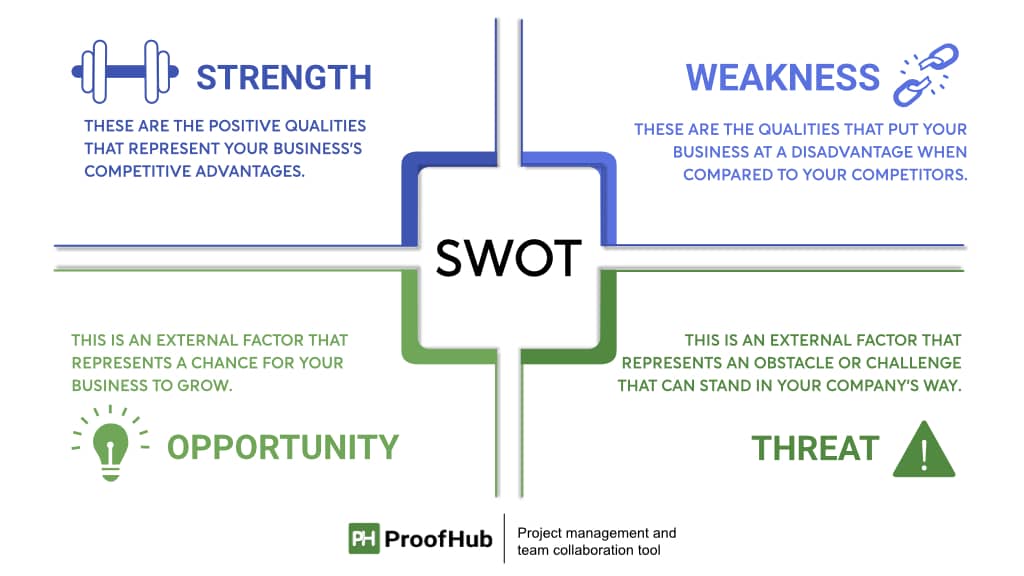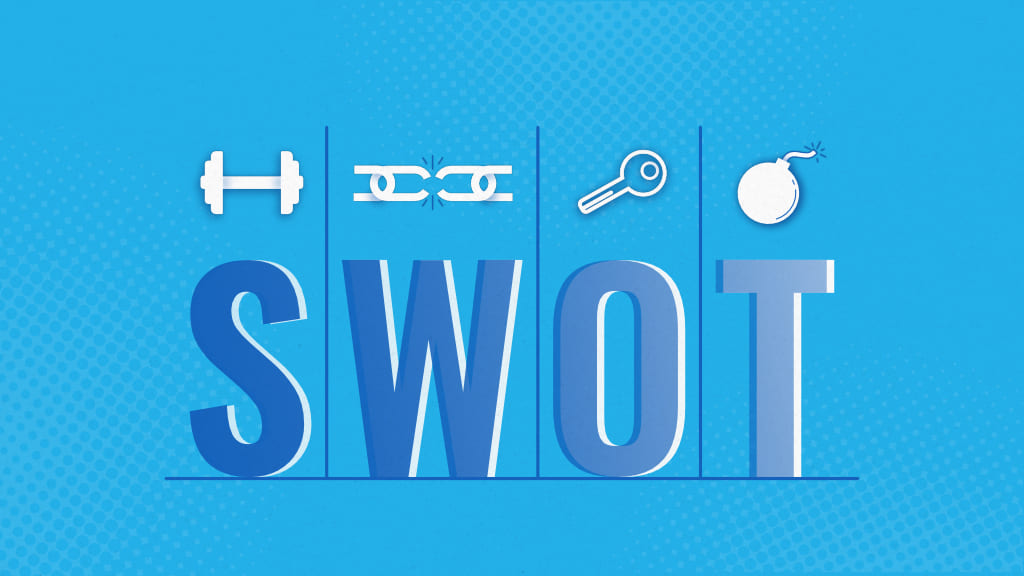Introduction
“What do you eat when you get peckish?”
I have no idea what this means, but apparently, Edward de Bono did. Why?
“To be creative and generate new ideas, we need to think outside of the box and look unusually at things, so we can come up with truly unique and novel ways to solve problems.”
And even though this is true for developing new products and services, it is also a great way to help you structure the thinking behind the project you’re currently working on.
If you’ve never heard of a SWOT analysis, it’s nothing scary and sounds like something you do when you go away for the weekend.
It stands for strengths, weaknesses, opportunities, and threats.
When you’re running a project (big or small), you need to know what’s working for you, where there are weaknesses that need to be worked on and how to take advantage of opportunities best.
Well, it’s not an easy task.
But this guide will give you some pointers on what to do and how to do it effectively.
What is SWOT Analysis?
A SWOT analysis is a strategic planning tool that helps determine the strengths, weaknesses, opportunities, and threats of a project or organization.
It helps you identify the internal (strengths and weaknesses) and external (opportunities and threats) factors that could affect the outcome of a project and the ways to gain an advantage over competitors.
It is a powerful method used to generate ideas and formulate strategies that lead to success.
This simple framework is the basis of many project plans in the PMBOK Guide (Project Management Book Of Knowledge). The framework helps draw attention to important facts, issues, strengths, weaknesses, and opportunities related to the project scope.
In fact, it encourages brainstorming and focuses your attention on information gathering and organizing.
| Random Fact: Used in a business context, SWOT analysis helps you carve a sustainable niche in your market. Used in a personal context, it allows you to strengthen your resolve. |
How to perform SWOT analysis for your project: 4 simple steps
You are the project or business unit coordinator, and the people report to you. They have a lot of questions you need to answer. You don’t want to appear unprepared, so you decide to organize a SWOT analysis for your project.
But you don’t truly understand what it is and how you conduct one?
Well, the goal of this analysis is not to predict the future but to understand it.
It’s used to identify areas that need improvement to develop strategies to adapt to challenges or take advantage of opportunities.
As previously said, the framework is relatively straightforward.
Several SWOT templates and designs are available, but it ultimately boils down to setting up a 4-cell table with a quadrant dedicated to each element.
The SWOT principles are displayed in these four squares.
Each square represents aspects of the project. It’s ideal to do this as a group to ensure that everyone’s voice is heard.

Strengths (S) – What do we do well that others might not?
These characteristics or features give your project an advantage over others in the industry, and they’re also what sets it apart from competing projects within your organization.
Weaknesses (W) – What don’t we do well that others might?
These are the characteristics or features that put you at a disadvantage relative to other projects in the industry or competitors in the market.
Opportunities (O) – Where could our strengths lead us?
These are factors that could help you achieve success with this project or venture, such as new technologies, changes in market dynamics, or other developments in your industry.
Threats (T) – Where could our weaknesses lead us?
These are factors that could cause you to fail with this project or venture — for example, economic downturns, significant changes in customer needs, and so on.
Making The Right Decision With Your SWOT
Projects are unique, and they have their challenges and obstacles, and it can be overwhelming to see the potential issues you might come across while working.
After the initial project kickoff, the first checkpoint is conducting a SWOT. By analyzing these four factors, you’ll have a better picture of where your project is going and what could go wrong.
This analysis can be conducted as an exercise with your team or independently. I recommend doing this with your team to get more perspectives and identify more factors.
Make a matrix, define a few specific, valid questions, and see how it goes.
As a project manager, you’ll use this information to help you steer your team in the right direction and avoid roadblocks that may lead to a project failure.
To get started with your analysis, work with your team to brainstorm answers for each category below.
- Who are your competitors?
- What is the thing that separates you from your competition?
- What’s your motivation?
- How quickly can it be completed?
Take stock of all the internal elements that contribute to your success and failure as a team or organization. Write down all the strengths (what works well) and weaknesses (which could improve). Note: Strengths and weaknesses are internal factors within your control.
Look at all the external elements that may positively or negatively affect your team or organization. Write down all the opportunities (what works well) and threats (which could improve). Note: Opportunities and threats are external factors outside of your control.
| Bonus Tip: Use a SWOT to uncover problems impacting your project and the possibilities that can make it successful. However, it should be noted that this is just one of many strategies available, not a prescription |
How can ProofHub help you categorize your SWOT analysis data
SWOT analysis is a structured process used by an organization in developing a strategic plan for goal and mission accomplishment. It examines an organization’s strengths, weaknesses, opportunities, and threats in its business environment.
In the world of project management, many complicated things may hinder your progress. You may have heard about it, but you probably don’t know precisely what and how to use it.
ProofHub is a top-rated, versatile team collaboration and project management software that can help you conduct an effective analysis of your projects. You can use various tools of ProofHub to categorize the data from your analysis into meaningful, actionable information.
It also allows you to create as many custom fields as you want.
These custom fields can store the data collected during the analysis. You can also create various groups of custom fields and add different sets of custom fields to other groups. You can create different groups for each category in which you want to store the data.
For example, if you are working on a web development project and want to conduct an analysis, you can create multiple groups, such as Strengths, Weaknesses, Opportunities, and Threats; and add all the custom fields you need for that project under these groups.
If your project involves creating three websites, you can easily use these groups for all three websites or any other future projects. You can reuse these groups repeatedly without having to waste time creating new ones each time.
This way, ProofHub will allow you to keep track of all the data you have collected during the process and help you keep it organized.
Takeaway
I’ll admit that SWOT is not typically my favorite thing to do; however, it is a valuable technique to help you focus on project-related issues.
Oftentimes, too many cooks in the kitchen can cause more problems than they solve.
It will help you avoid this pitfall and arrive at an optimal solution with the team’s full support.
If you’ve never run a SWOT before, I hope this post has taught you the importance of using one as part of your project planning and showed you how easy it could be by providing a template to guide you through it.
Regarding any of your projects, make sure you take the time to conduct a proper analysis before proceeding; you’ll be glad that you did.
FAQs
SWOT analysis is an acronym for?
SWOT analysis is an acronym for a deliberation between Strengths, Weaknesses, Opportunities, and Threats.
What is SWOT analysis used for?
SWOT analysis is a common technique used to understand the relative strengths and weaknesses of your business. It allows you to identify potential threats and opportunities in the marketplace.
How SWOT analysis helps in strategic planning?
Analysis is the first step to solving any problem you might have. This sample SWOT Analysis shows how you can use simple and easy steps to identify the strengths and weakness of a business or product, as well as its opportunities and threats.
What is Pestle analysis?
Pestle analysis is a framework for understanding the external macro-environment facing a business. The components of this framework are Political, Economic, Social, Technological, Legal, Environmental and Cultural.

